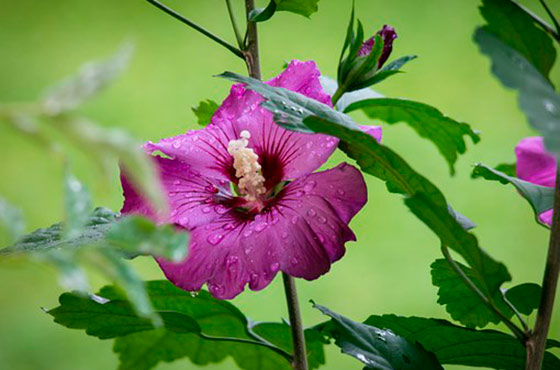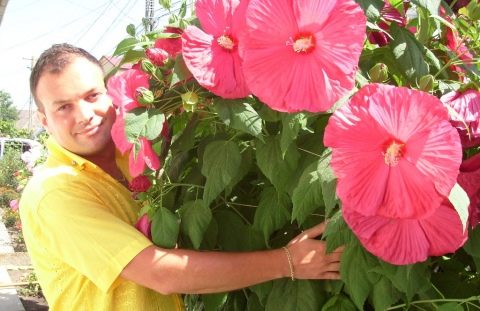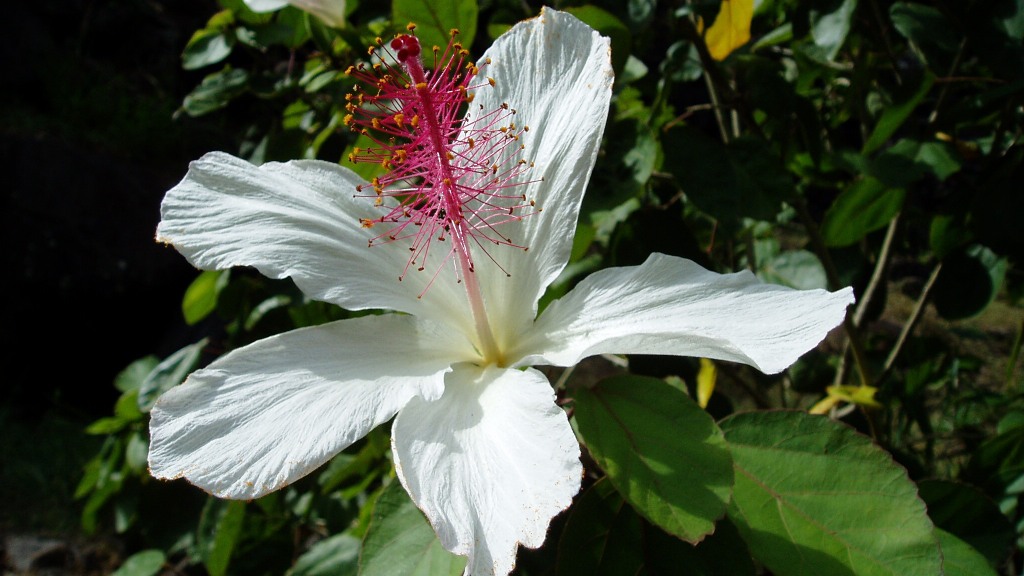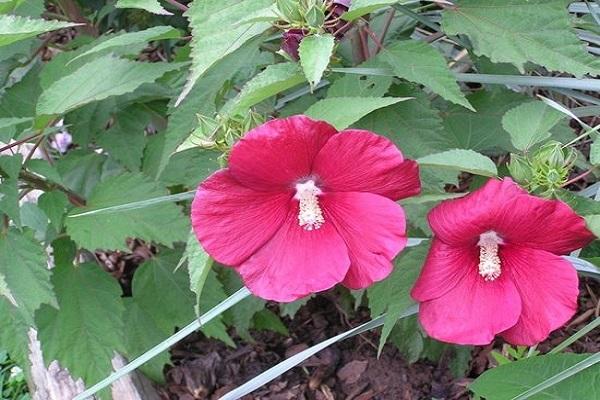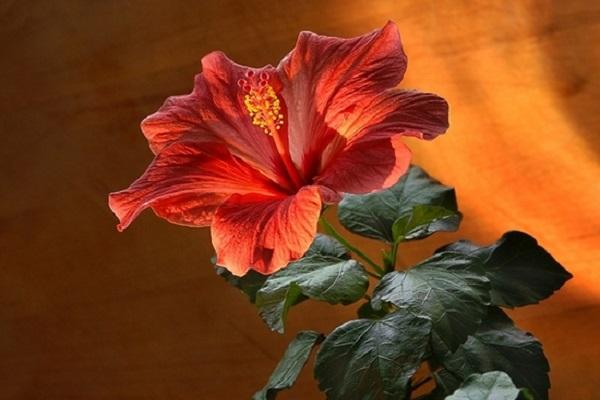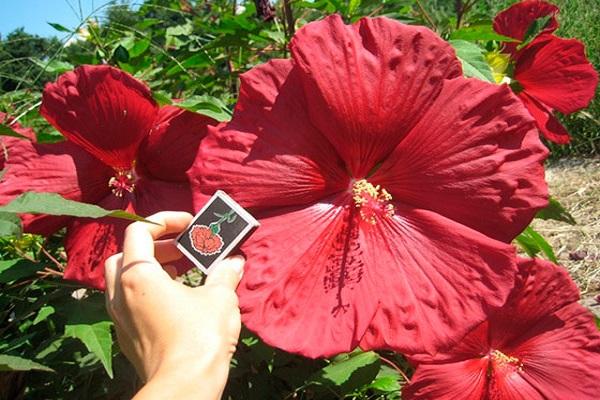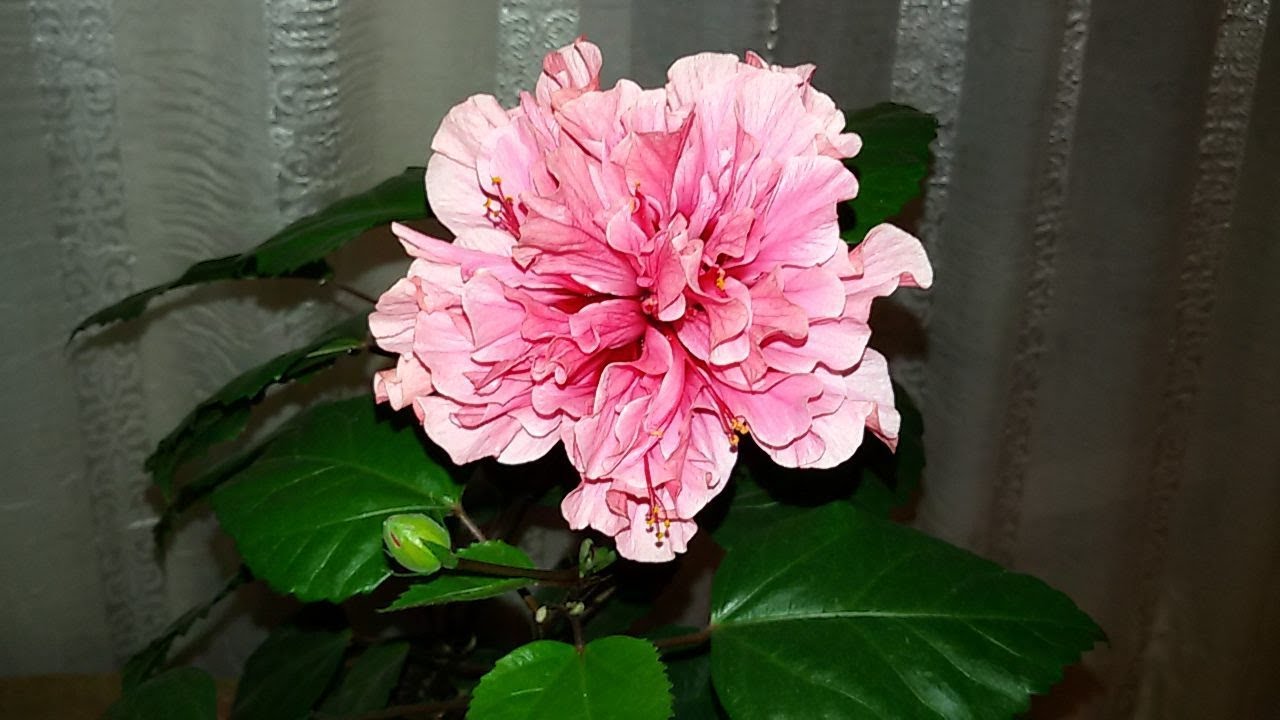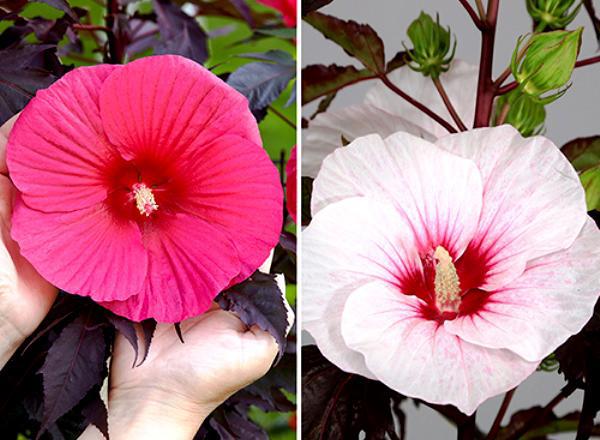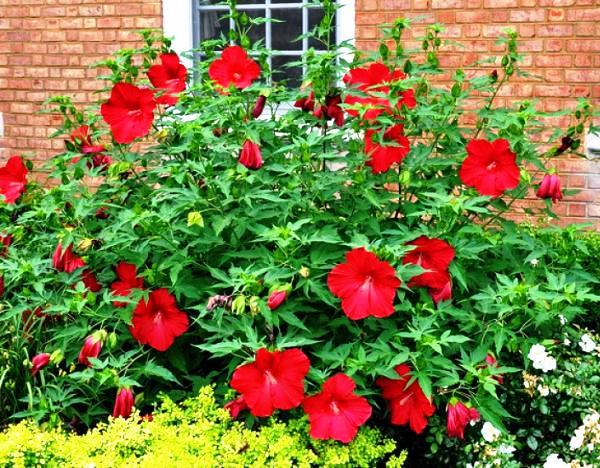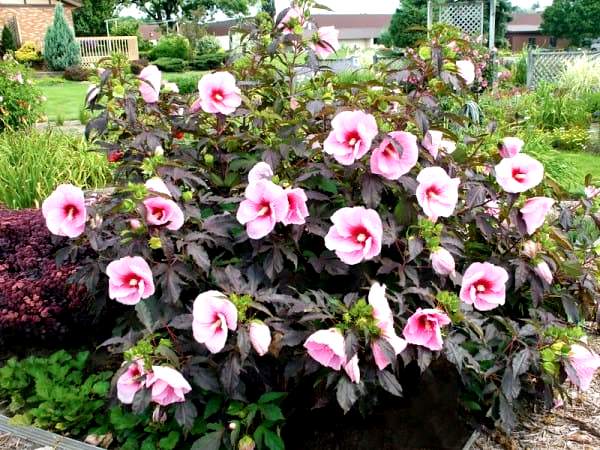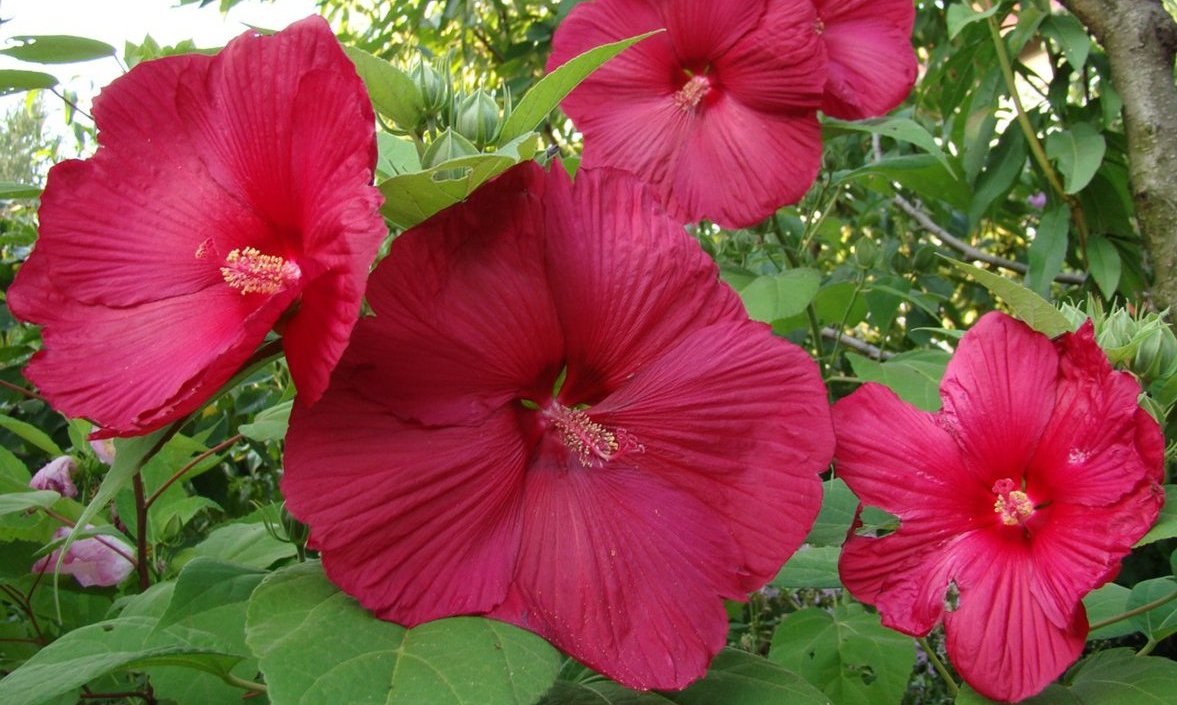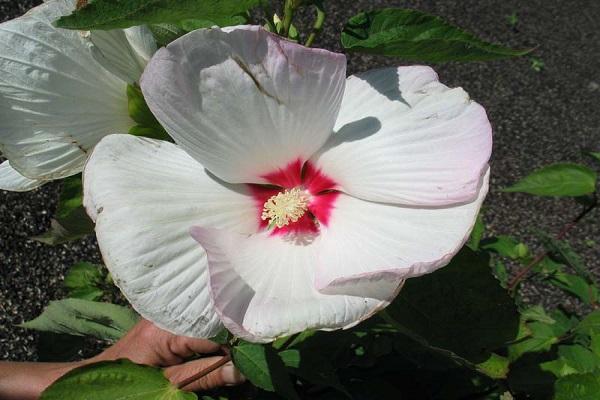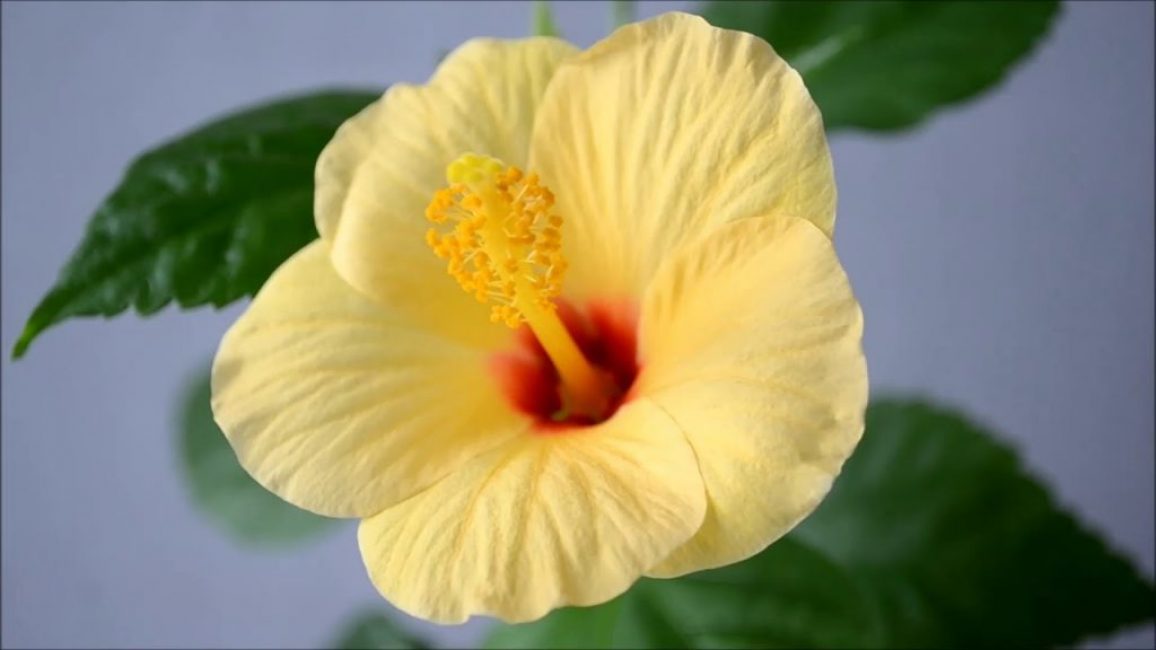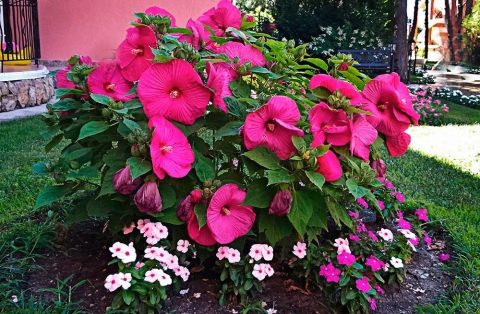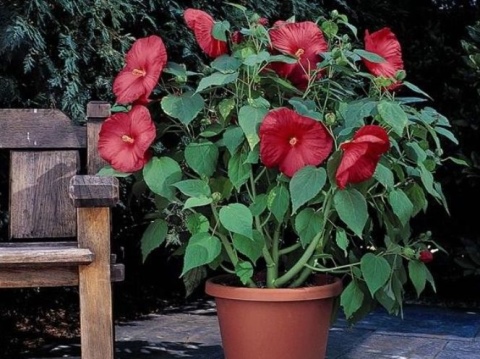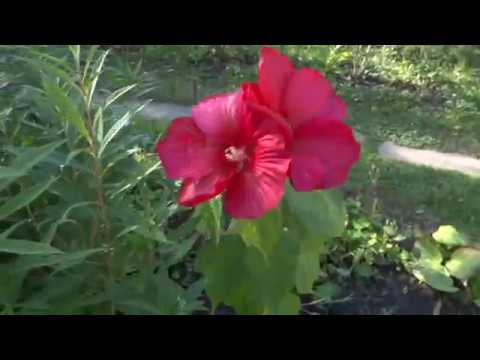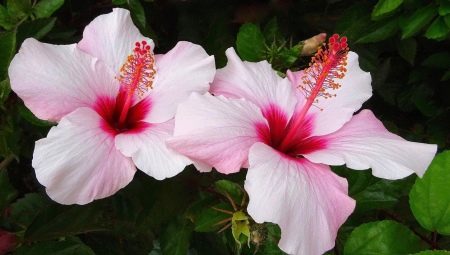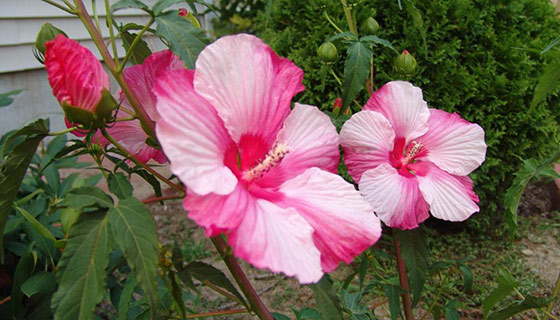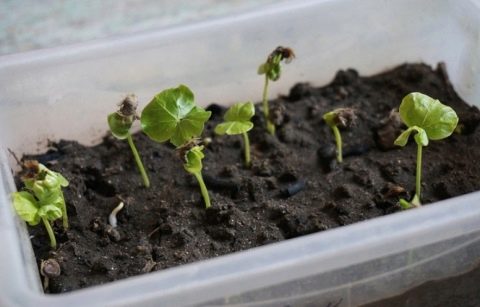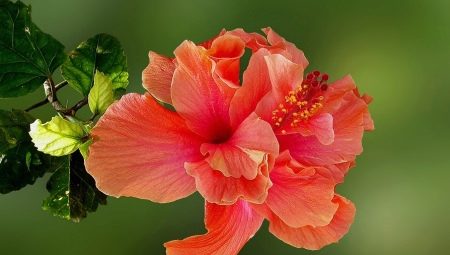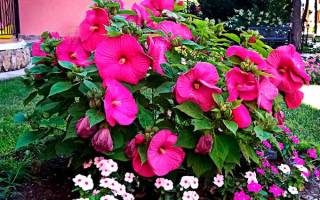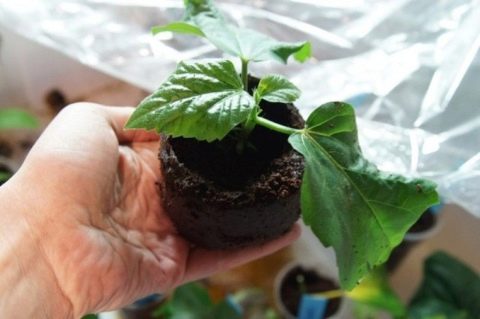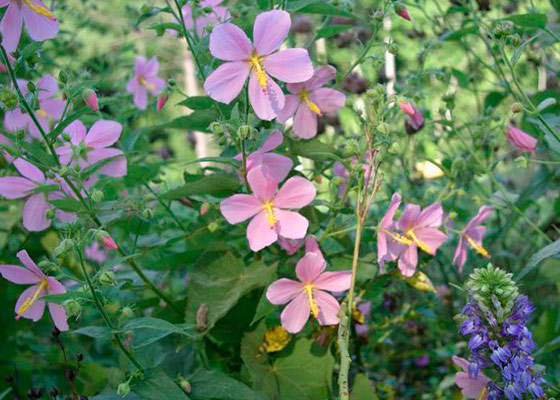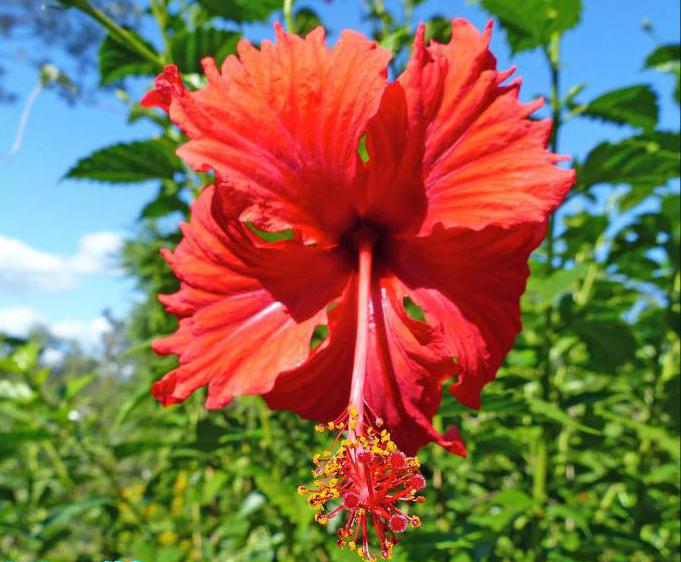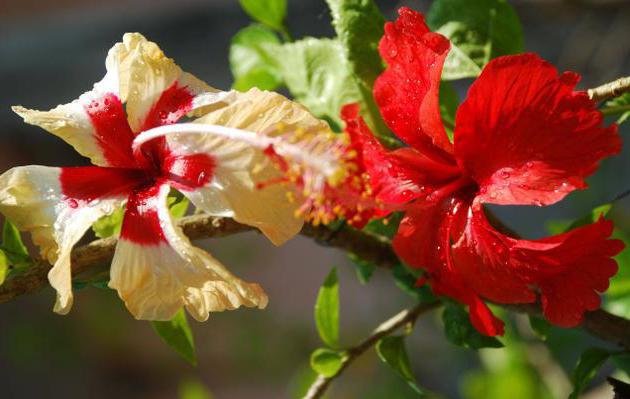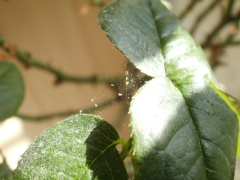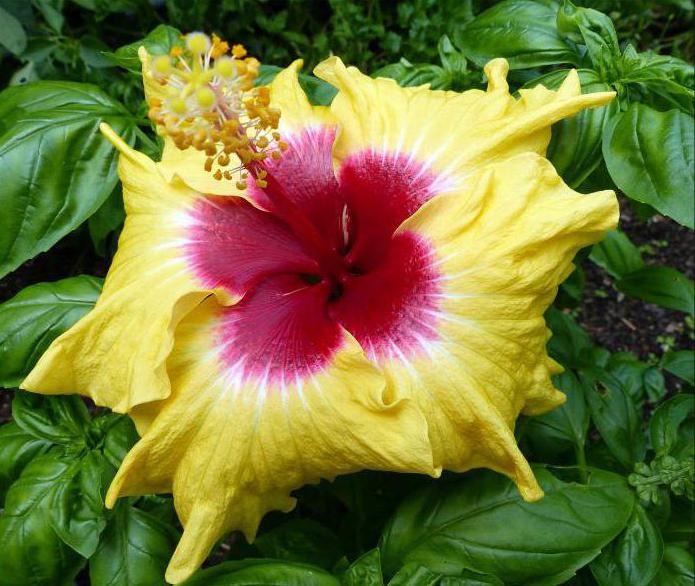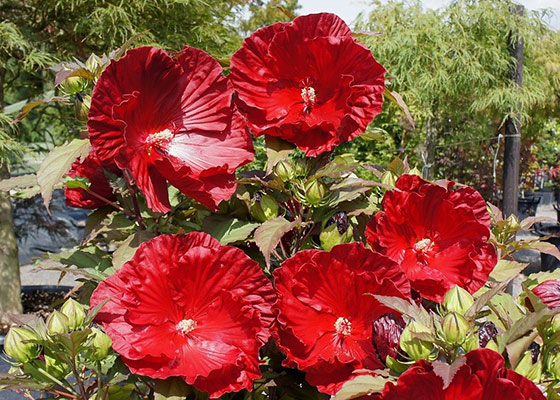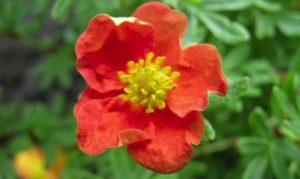Reproduction of hibiscus: cuttings
Marsh hibiscus propagates by cuttings and seeds. Both methods are almost equivalent, but cuttings are the simplest and most common among gardeners. Cuttings, suitable young shoots, are cut with a sharp knife in the spring and, having treated them with special preparations that stimulate root formation (for example, Kornevin, Epin, Zircon), root them in a mixture of sand and peat, first placing them in a mini-greenhouse and keeping at home for one and a half to two months. The optimum temperature for better rooting is 23-28˚С. In June, they are planted in open ground.
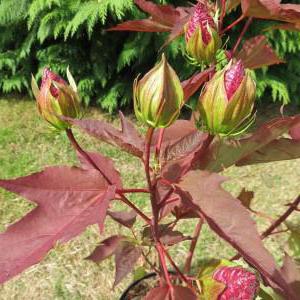
In December, experienced gardeners recommend mulching a rooted seedling with spruce branches, leaf compost or a special non-woven covering material - lutrasil. With the first snowfalls, you can scoop up more snow to the trunk. It will protect the soil from freezing, and young roots from death.
Cuttings can also be carried out in summer. In this case, rooted cuttings that have turned into seedlings are planted the next year and their chances of successful survival are incomparably greater.
Garden hibiscus: care and reproduction
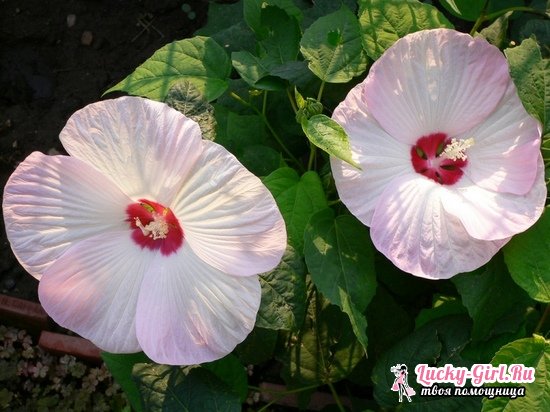
Hibiscus pruning begins at the moment when the bush reaches a height of 60 cm: it is shortened exactly by half. Such a move will not allow the bush, which has just entered the phase of preparation for flowering, to grow and form new foliage. The main pruning of hibiscus is done in the middle of winter, when old shoots are destroyed, and only the woody part of the bush remains.
If you ignore pruning and pinching, the hibiscus will continue to stretch upward, but will not gain the required density, and the decorative hedge will be sparse and thin. Also, dead flower heads are definitely destroyed, which will not only contribute to the appearance of new flowers, but also prevent the formation of seeds and the subsequent self-seeding of the plant.
Hibiscus reproduces on its own when the pods turn brown in place of the flowers and begin to fall to the ground. Not all gardeners like this moment, because if you do not control this process, next year the whole garden will be in young hibiscus bushes, and its conceived drawing will be disrupted. However, if you just want to collect seeds for further propagation of the plant, do not destroy a few dry flower heads, wait until the pods appear and their surface darkens. You can also propagate hibiscus through cuttings, taking several young shoots from it in the spring and rooting them into the ground.
In December, it is recommended to cover the soil around the bush with foliage or tree branches if there is a likelihood of a lack of snow: the roots often dry out from freezing of the soil. Other factors, according to experts, do not play a special role in the care of marsh hibiscus. Like other shrubs, it is susceptible to aphid attack, from which only frequent treatment with natural remedies or rare - with chemicals can protect.
The main problems inherent in this plant - the lack of flowers, leaf fall of its lower part, yellowing of foliage and its lethargy - are directly related to a lack of moisture and light, as well as an excess of nitrogenous fertilizers.
Therefore, if you want marsh hibiscus to delight you throughout the year with its healthy appearance, focus on the illumination and constant moisture of the area where it grows.
Blooming hibiscus care
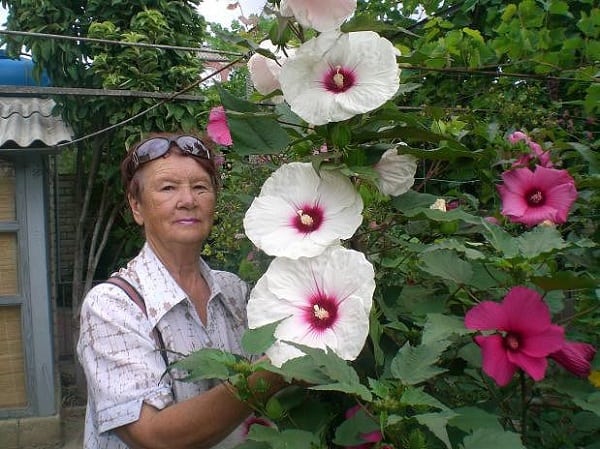
- Watering. It should be generous - it's not for nothing that this flower is called a marsh flower! But the water shouldn't get stagnant near the roots, so don't add more than 5 liters at a time.In addition, it should not be ice-cold - in the summer heat the water for irrigation in a large vat in the sun.
- Top dressing. In the spring, pamper the bush with nitrogen (an infusion of rotted manure or humus), and in the fall - with a phosphorus-potassium composition.
- Pruning. The crown of the marsh hibiscus can be used for shaping scraps. They are carried out before the beginning of the growing season - in early spring, or even at the end of winter. In addition, remove unnecessary (thickening the crown), as well as frankly diseased branches.
- "Manual therapy". This decorative culture requires loosening of the soil near the trunk - due to frequent watering, it can take on a "crust", and this will not allow the roots to breathe. Well, of course, do not forget to weed out the weeds.
- Diseases. This bush practically does not get sick, unless there will be a "joint" in the care. For example, in saline soil near a bush, off-season "leaf fall" will begin, and with excess nitrogen, the bush will go on strike and refuse to bloom.
- Pests. A spider mite can attack the hibiscus, and then the bush will have to be sprayed with an insecticide.
You will learn more useful information about the manners of this garden flower and the intricacies of its cultivation from the video:
Wintering in the house
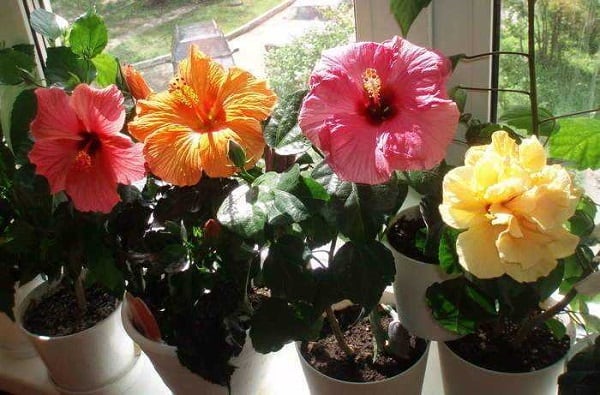
Water the plant often, but with settled water.
When the bush grows to 60 cm, carry out the formative crown pruning.
Good soil for indoor hibiscus: 4 shares of sod land, 3 shares of leafy soil, 1 share of sand and humus. If desired, such soil can be enriched with bone meal and / or charcoal.
The bush will like regular spraying (use warm water), wiping with a wet handkerchief, winter lighting. Keep it on a west or east windowsill.
As for nutrition, in winter, give hibiscus a potassium-phosphorus mineral water, and if it blooms, nitrogen mixtures. Application frequency - once a month after watering.
Wintering in the garden
Hibiscus is successfully grown even in Siberia. The main thing is that the garden is well covered with snow in winter.
The lowest winter temperature for this culture is up to -30 degrees.
If wintering is the first or second, cover the tree trunk circle with deciduous compost or spruce branches. You can also use the achievements of modern science - say, buy lutrasil or roofing felt. And as soon as the first snow falls, shovel more of this "natural blanket" onto the bush.
Seed propagation
The culture is propagated by seeds, layering and cuttings. Many varieties are fairly easy to self-seed. This can be clearly seen from the small seedlings sprouting under the bushes from fallen seeds. Having carefully dug up along with a part of the land, they can be transplanted to another place. You can also sow the seeds yourself in open ground in a bright and warm area. Before sowing, the seeds of the tree hibiscus (photo below) should be kept overnight either simply in water or in a weak solution of potassium permanganate. Having planted them, you need to water and cover with a film, which subsequently will need to be periodically removed for airing.
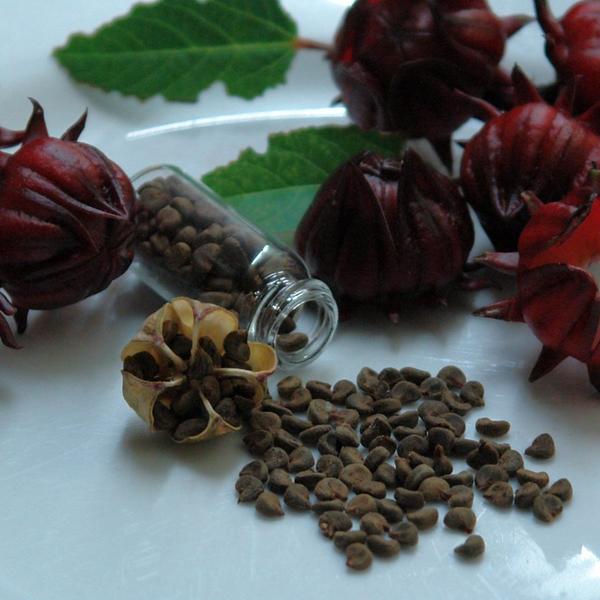
You can sow seeds before winter. In this case, the crops should be covered with fallen leaves or spruce branches. It should be noted that hibiscus grown using seeds does not repeat the varietal qualities of the parent plant.
Reproduction
Hibiscus propagates by seeds and cuttings. The last method is the most common. Before the beginning of spring, dry branches are cut off, placed in a bowl with water or wet sand. After about two weeks (or earlier), the rudiments of the roots appear. After that, the plant is planted in a separate container.
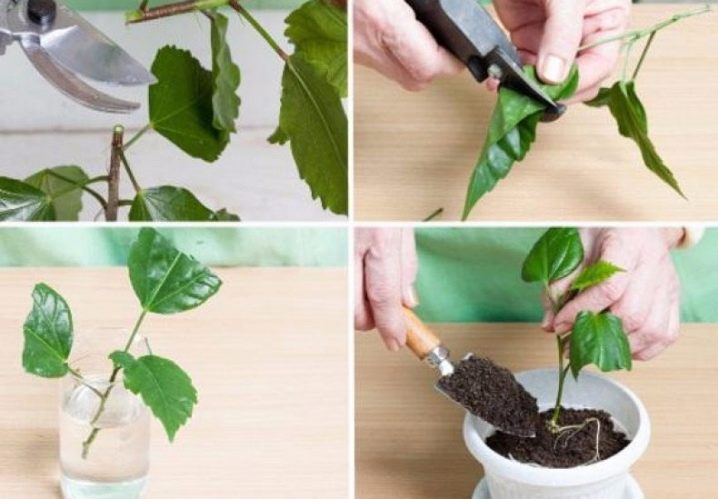
Seed propagation is a more laborious process than propagation by cuttings. However, it is also popular with experienced florists. You need to purchase seeds or grow them yourself.
The seed should be soaked in a special stimulating solution called Epin.
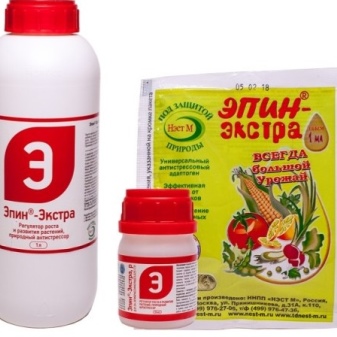

After 12 hours, the seeds are taken out. Sowing is carried out in a special box with sand and peat in a 1: 1 ratio.The box with seedlings is covered with a glass lid and placed in a place with a temperature of at least 25 and no more than 27 degrees. It is necessary to regularly spray the soil and ventilate it. As soon as a shoot with leaves (at least two) appears, it is necessary to plant it in a small pot. Such a hibiscus will bloom no earlier than three years later.
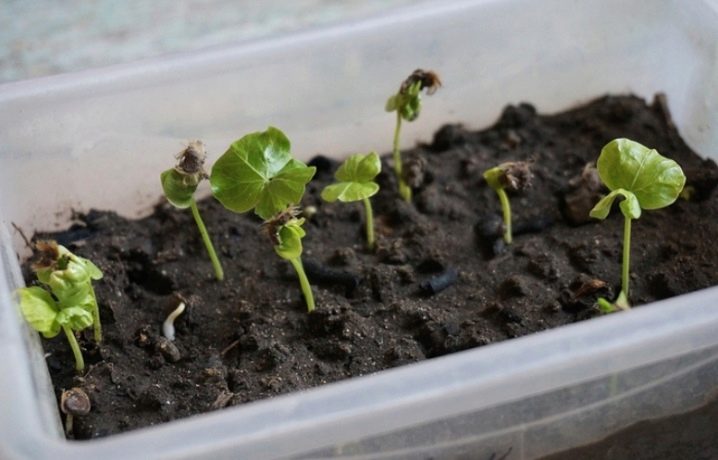
How to properly prune indoor hibiscus
Some Dutch hibiscus grows in a compact bush, and if you start to pinch or cut them, they grow long branches, which looks ugly. But pinching stimulates flowering, because buds only appear on new branches. Most species respond well to this event, produce more shoots and look much neater. Also, this method is used to give the crown the desired shape. You can form hibiscus in the form of a standard tree.

Hibiscus pruning and crown shaping
Large varieties are cut every spring, shortening the branches by a third of the length. Curved and dry shoots are also removed. Sometimes, if required, pruning is repeated in the fall. It is better to make an incision above the bud that is facing outward, then new shoots will not grow inside the crown. Rooted cuttings, consisting of one trunk, are also pinched to stimulate the formation of side branches.
What is trimming for?
The first pruning of hibiscus is carried out when the shrub reaches 0.6 m in height. It is shortened by half its height, thereby stimulating active branching and foliage formation. The main formative pruning of the crop is carried out by the end of winter, cutting out dry flower stalks, old stems and leaving the woody part of the shrub. Note that pinching and pruning are mandatory procedures, which cannot be ignored, since the hibiscus will stretch upwards, will not gain the required volume of green mass, i.e., it will significantly reduce decorativeness.
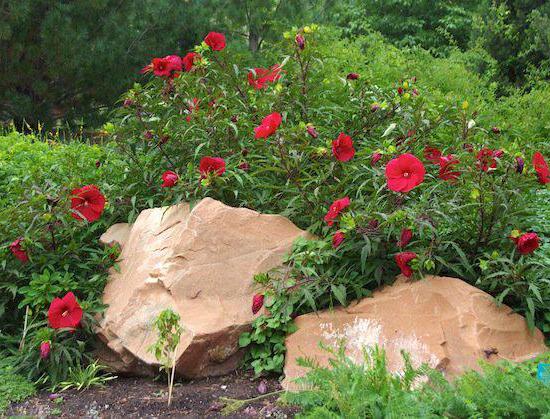
These are the main stages of caring for such an exotic plant as marsh hibiscus. Growing this beautiful culture is a simple procedure and is within the power of the most ignorant gardener.
Novice growers usually do not risk growing perennial garden plants from seeds, citing special technological conditions. It is easier for them to buy a ready-made bush or a cut. In reality, everything is not so difficult. It's about growing hibiscus from seeds.
(Hibiscus) is an unpretentious plant, quite drought and frost-resistant (rhizomes survive at temperatures down to -30 ° C). For planting in open ground, hibiscus seedlings are grown from seeds.
In March, pre-soak the seeds in a stimulant solution (humate, zircon, or others according to the instructions). Stir occasionally to help them absorb moisture. Then wrap in a damp cloth and place in an open plastic bag. After 3-4 days, most of them germinate. Each seed that has hatched is sown in a separate glass filled with nutritious soil for flowers, in peat-humus pots, and covered with polyethylene.
To protect the seedlings from the black leg, it is necessary to water with a solution of foundation.
 When it gets warmer outside, take out the hibiscus seedlings to fresh air, first for a few minutes, gradually increasing the time of their exposure to the sun and wind. The hardening process takes about two weeks.
When it gets warmer outside, take out the hibiscus seedlings to fresh air, first for a few minutes, gradually increasing the time of their exposure to the sun and wind. The hardening process takes about two weeks.
Seedlings are planted in open ground in May, transferring plants from cups together with a lump of earth, at a distance of 30-45 cm from each other, when the threat of night frosts has passed. Choose a sunny place, shade is undesirable. If, after all, a frosty night is expected, cover them with spunbond, old buckets, etc. Young hibiscus seedlings should not be mulched, as they no longer develop well. Do this only 2-3 years after planting. The optimal layer of mulch is 4-5 cm of straw or peat.
Of the diseases, hibiscus can be affected by chlorosis (yellowing of the leaves), if a danger is detected, spray the bushes with a solution of iron chelate.It is also useful to water under the root with a solution of the foundation and spray it over the leaves.
In the budding stage, pamper your pets with leaf feeding (in the evening), which promotes earlier flowering, and the flowers become larger and brighter. In herbaceous hibiscus, the ground part dies off for the winter.
Division can be started from the third year after planting.
For details on how to grow hibiscus on your site, and how to properly care for it, see the next video.
My hibiscus
It is not easy to become a breeder, but it is possible. The main thing is to be patient, have hard work and have a great desire to grow a plant, unseen until now.
And I offer a small instruction on how to grow hibiscus from seeds.
You should have two different hibiscus flowers at the same time. then you will get your own bred variety.
Diseases and pests
In general, hibiscus is quite resistant to diseases and insect attacks, if the care is organized correctly. However, if something is overlooked, unpleasant situations are possible.
If the hibiscus lacks essential trace elements or moisture, it will begin to shed foliage and inflorescences. If you notice such signs, replace the topsoil or transfer the plant to fresh soil, provide quality watering. If the foliage becomes yellowish and falls off, check how high-quality the water you water the flower with. It may be too chlorinated. Before watering, the water should stand for at least a day.
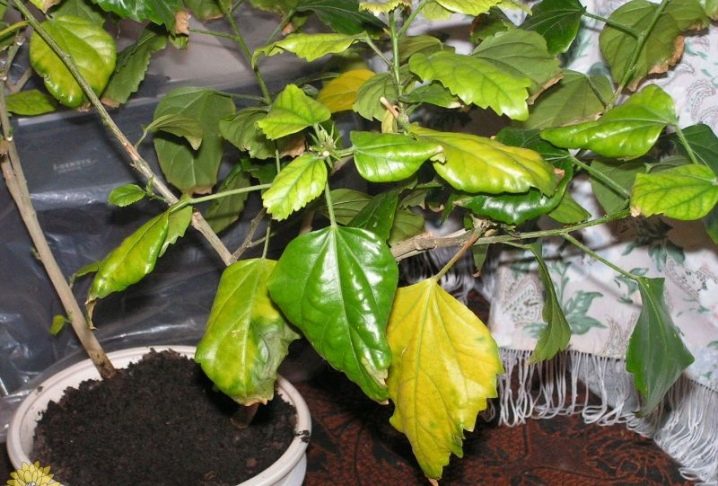
The lack of flowering is a sign of a possible oversaturation of the soil with fertilizers or improperly organized lighting. Light can be either lacking or abundant. You can solve these problems by building competent lighting. It is also a good idea to temporarily stop fertilizing.
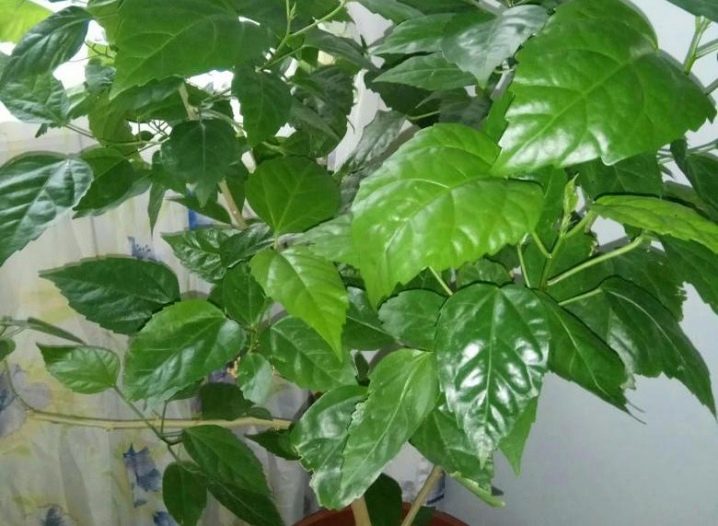
Too low a temperature leads to decay of the root system. The cold is harmful to the flower. If you do not transfer the plant to a warm place in time, it may even die.

If the room is too dry, scabbard and spider mite attacks are possible. In this case, you should rinse the foliage with a soap-alcohol solution. In advanced situations, you have to resort to the help of special chemical compounds.


You can get acquainted with the features of growing marsh hibiscus in a garden plot in the following video.

